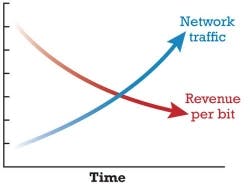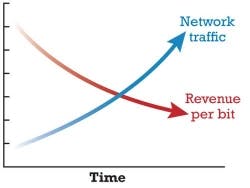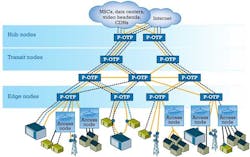Packet-optical transport platforms can help solve the challenges of increasing network capacity and reducing network costs.
Service providers around the world are under escalating pressure to increase network capacity for rapidly scaling broadband services and simultaneously reduce the cost of those services. The primary driver for these conflicting goals is the fact that traffic is increasing on relatively flat or declining revenue–resulting in a decrease in revenue per transported bit in the network (Figure 1).
Naturally, it's difficult to spend money to increase infrastructure capacity and simultaneously reduce costs–particularly if you continue to deploy the same infrastructure and maintain the same operational constructs as you have in the past. Since "more of the same" strategies are unlikely to yield new insights, it is necessary to consider what's changed in order to create new opportunities to increase IP services capacity and simultaneously reduce cost.
Let's start by considering the paradigms that often shape the way we think about networks. One such paradigm is that virtually all services have transition-ed to IP, and routers have taken on critical and expanding roles to facilitate these rapidly expanding services. As packet services scale, TDM services have transitioned from representing the majority of network traffic to an increasingly small minority of primary services. As a result, many service providers have deployed routers as an alternative to TDM-optimized transport technologies such as SONET or SDH.
In most cases, this move-ment away from SONET/SDH started in the core and has begun to move toward the edge. For many, pseudo-wire support of legacy services and use of routers to support IP services seemed a logical strategy for network convergence and packet-services scale. However, a combination of changing traffic patterns, new high-performance/lower-cost, packet-optical technologies, and the aforementioned economic pressures to reduce costs are altering the underpinnings of many networks in favor of packet-optical transport.
Exploiting new packet technologies
While applications are predominantly IP-based (Web browsing, Internet search, Internet applications, VoIP, IPTV, over the top video, etc.), these applications are delivered over Ethernet networks using E-Line, E-LAN, or E-Tree services. The vast majority of services today are switched, aggregated, and transported as Layer 2 Ethernet services between the subscriber and the network source of the application or content.
For well over a decade, these Ethernet services were transported over networks using SONET or SDH infrastructure. Many service providers deployed Carrier Ethernet systems to provide more cost-
effective Ethernet services transport. However, these early systems were often proprietary and lacked fully evolved standards to provide consistent quality of service to meet diverse customer needs. This situation led many service providers to deploy routers with MPLS.
MPLS-based routers are high-performance systems that sell for a substantial price premium over Carrier Ethernet systems. As recently as two years ago, that premium was justified because scalable, standards-based, consistently high-performance Carrier Ethernet systems were hard to come by and their performance often disputed.
In June of 2009, a new transport-optimized Ethernet specification, 802.1Qay, also known as Provider Backbone Bridge-Traffic Engineering or PBB-TE, was ratified by the IEEE. This new standard enabled connection-oriented Ethernet (COE) transport with massively scalable, high service level agreement (SLA) Ethernet services and Ethernet economics. The result was an approximate 90 percent reduction in the cost of scalable Ethernet services transport when compared with using high-performance routers for Ethernet services transport. A second COE set of standards based on MPLS-TP is currently in process and anticipated to yield similar economic efficiencies when implemented on Carrier Ethernet switches and packet-optical transport platforms.
Ethernet service level performance monitoring and reporting also has dramatically improved in recent years. New Ethernet operations, administration, and maintenance (OAM) standards and specifications, such as Y.1731 and 802.1ag, provide standardized SLA management and reporting. The combination of high-quality packet transport and detailed SLA management has taken Ethernet services performance to new levels. This, combined with the economic benefits of COE transport, should lead all service providers to re-evaluate their Ethernet transport strategies.
Implications of changing traffic patterns and scale
For more than 100 years, network traffic was dominated by voice services, of which more than 80 percent stayed local and less than 20 percent was long distance. During this era, highly optimized switching infrastructures were developed and deployed to cost-effectively switch local services locally, minimizing the cost of backhaul.
As services shifted from TDM voice to IP voice, video, and data content, the early strategies were to deploy edge-based routers to optimize support for new IP services, much the same way that voice switching infrastructures were previously deployed. However, as IP-based services have evolved and matured, the vast majority of traffic is now sourced from and to the Internet, or other content delivery networks well upstream from local access and metro networks. Most service providers believe this fundamental traffic pattern shift has completely reversed the historic 80/20 rule where 80 percent or more of traffic is believed to be flowing to/from upstream Internet network access points, data centers, mobile switching centers, or IPTV headend sources.
Figure 2. Network optimization has shifted from edge-optimized local routing and switching to backhaul-optimized connectivity of subscribers and upstream content. This means less of an emphasis on deeply distributed switching/routing of individual services and more focus on the low-latency, cost-optimized transport of aggregated services.
Consequently, network optimization has shifted from edge-optimized local routing and switching to backhaul-optimized connectivity of subscribers and upstream content (Figure 2). This condition of many services sharing the same backhaul circuits to upstream content sources is a key driver for higher-capacity metro and regional transport.
Content is also increasingly video in nature, resulting in dramatic increases in per-subscriber traffic flows and the duration of flows. As video content becomes more mainstream and more personalized devices enable greater frequency of access, the traffic generated by these services will continue to scale. The result for most service providers has been and is projected to be a continuing doubling of packet services traffic every 12 to 24 months, or an average of a 10X increase every five years.
When services were increasing 10X from 1-Gbps to 10-Gbps routes, the increases were addressed by simply adding more ports on SONET/SDH systems or routers. However, as service aggregates exponentially increase from 10 Gbps to 100 Gbps and then to 1 Tbps, the implications to equipment scale and the costs become dramatic–far exceeding the simple addition of more ports.
SONET/SDH systems have proven too constrained to support this level of network-wide scalability. When considering a 10X increase in port/processing requirements and the fact that routers cost nearly 10X more than COE transport systems, it becomes clear that continued scale using routers for transport is also not economically viable. As a result, new architectural approaches are required to address the low-latency, backhaul-optimized transport of metro, regional, and core networks.
Cost-optimizing for new traffic models and scale
The combination of changing traffic patterns and the evolution of Ethernet to COE for transport has opened the door to new Ethernet-optimized network architectures. However, the scale of increasing packet traffic will still challenge the fiber capacity of most networks.
In many metro markets, sufficient fibers are available to deploy 10-Gigabit Ethernet (10GbE) as a dedicated service per-fiber. In other cases, fiber constraints or the cost of leasing dark fibers mandates a DWDM approach to drive multiple 10GbE or future 40GbE and 100GbE transport services per fiber.
When considering the backhaul-intensive nature of services, these DWDM-based transport networks will have an increasing number of wavelengths transiting through nodes with relatively modest add/drop requirements. In these cases, optical-level grooming with wavelength-selectable switching reconfigurable optical add/drop multiplexers (ROADMs) provide a materially lower-cost architectural approach over straight DWDM terminals.
Historically, platforms with these capabilities were limited to the core and were complex and costly. An entirely new class of product, called packet-optical transport platforms (P-OTPs), has emerged to address this combined packet and optical functionality.
P-OTPs provide powerful new capabilities for reducing network cost and complexity. The integrated view of the network, where one platform simultaneously supports Ethernet services with COE transport, SONET/SDH, DWDM, and ROADM functions, also introduces the opportunity for dramatic reductions in the cost and complexity of planning and managing networks. Multi-layer planning and management software now enables network-wide planning and network design optimization. The result is better use of network resources–which means less equipment to transport services.
In addition to minimizing equipment, this multi-layer approach to planning and managing networks also yields higher performance due to better insights into the interdependencies of services and transport layers, with lower operational costs. The combination is a powerful tool for offsetting the economic pressures to reduce costs while scaling capacity.
Of course, routers have been playing and will continue to play critically important roles for Layer 3 IP routing functions at multiple points across the network, including many core MPLS applications. However, the transport of IP services will increasingly be provided by new packet-optical transport systems to more cost-effectively match service requirements with services scale and economic constraints.
Frank Wiener is the vice president of marketing and market development for Cyan. He has held a range of individual contributor and executive leadership roles spanning engineering, product management, marketing, sales, and general management.
Past LW Issues


